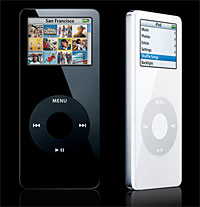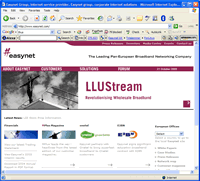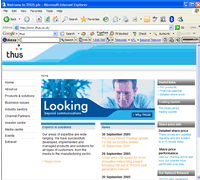 Canon are trumpeting that they are “bringing IXUS style and performance to the wireless age” with the release of their PowerShot camera.
Canon are trumpeting that they are “bringing IXUS style and performance to the wireless age” with the release of their PowerShot camera.
Essentially a Powershot SD450 with Wi-Fi (IEEE 802.11b) bolted on, the compact camera comes with a 5.0 Megapixel CCD sensor, 3x optical zoom, 2.0″ LCD display and 14 shooting modes for creative experimentation.
The addition of the Wi-Fi gubbins means the SD430 offers direct printing to any to any Canon PictBridge compatible printer courtesy of the supplied Wireless Printer Adapter (WA-1E).
An Auto Transfer mode automatically transfers images to a nearby PC (with Canon’s software installed) while the Wireless Remote Capture lets users fire off snaps from their PC – great fun for candid party shots and capturing scampering squirrels in the garden. If that’s your bag, of course.
 The camera can be registered with up to 8 target devices including wireless access points via a secure communication system to prevent eavesdropping or interception of your photographic masterpieces.
The camera can be registered with up to 8 target devices including wireless access points via a secure communication system to prevent eavesdropping or interception of your photographic masterpieces.
As well as industry standard WEP, the SD430 employs WPA-PSK with TKIP/AES encryption for enhanced data security.
“With wireless technology extending beyond the office to personal home networks, Canon expects Wi-Fi support to be the next big trend in the digital photography market,” insisted Mogens Jensen, Head of Canon Consumer Imaging Europe.
“The Digital IXUS WIRELESS delivers freedom and ease-of-use that consumers expect from wireless devices,” he continued.
 Although we naturally warm to the convenience and sheer ‘techiness’ of Wi-Fi enabled digital cameras, we remain to be convinced that the technology has reached maturity yet.
Although we naturally warm to the convenience and sheer ‘techiness’ of Wi-Fi enabled digital cameras, we remain to be convinced that the technology has reached maturity yet.
After all, firing off images wirelessly is no quicker than using a standard USB dock, there’s no built in browser or infrastructure for shifting images when you’re away from home (or at a photo printing lab, for example) and, of course, all that WiFi-ing is going to give your camera’s batteries a slapdown.
 We speak from some experience here too, after foolishly being seduced by Sony’s innovative – but frankly pointless – Bluetooth feature on its 20002 DSC FX77 camera.
We speak from some experience here too, after foolishly being seduced by Sony’s innovative – but frankly pointless – Bluetooth feature on its 20002 DSC FX77 camera.
After an eternity of fiddling about with Bluetooth settings only to see images crawling onto our PCs, the novelty soon wore off and the thing was dumped straight back on to its USB cradle.
Mind you, it was fun taking photos from a PC in the next room until the Bluetooth connection went tits up.
Back to the SD430, we can also add that it comes with an all-important cool blue light, offers manual and auto shooting modes with stitch assist, and weighs in at 130 g (4.6 oz) in a pocketable 99 x 54 x 22 mm (3.9 x 2.1 x 0.9 in) case.
Pricing to be announced.
 More details about Jason Tomczak’s class action against Apple for releasing defective iPod Nanos have emerged on The Inquirer’s site.
More details about Jason Tomczak’s class action against Apple for releasing defective iPod Nanos have emerged on The Inquirer’s site. The plaintiff alleges that with Steve Jobs whipping the Nano out of his pocket in a TV advert, Apple led consumers to believe the machine was durable.
The plaintiff alleges that with Steve Jobs whipping the Nano out of his pocket in a TV advert, Apple led consumers to believe the machine was durable. Ironically, things haven’t been helped by the iPod nano appearing on the scene straight after the phone’s launch, with the ultra-small pocket rocket holding 10 times the amount of songs for half the price
Ironically, things haven’t been helped by the iPod nano appearing on the scene straight after the phone’s launch, with the ultra-small pocket rocket holding 10 times the amount of songs for half the price As we reported last week, Easynet has been bought by Sky – as long as they get shareholder approval, but since Sky have offered a premium on Easynet’s shares, this should be a done deal.
As we reported last week, Easynet has been bought by Sky – as long as they get shareholder approval, but since Sky have offered a premium on Easynet’s shares, this should be a done deal. Even though Sky are buying into LLU, Easynet only cover around 250 exchanges and currently all the voice goes to BT (Easynet use the shared metallic path LLU option), while Sky are likely to want to take the phone service as well (they already have a SkyTalk package using CPS provided by THUS). Sky will need to invest to make this a reality as well as increasing Easynet’s coverage. They have said they want to go into around 1000 exchanges, so that’s a build out of around 750 – which won’t be cheap (probably another £100m’ish at least).
Even though Sky are buying into LLU, Easynet only cover around 250 exchanges and currently all the voice goes to BT (Easynet use the shared metallic path LLU option), while Sky are likely to want to take the phone service as well (they already have a SkyTalk package using CPS provided by THUS). Sky will need to invest to make this a reality as well as increasing Easynet’s coverage. They have said they want to go into around 1000 exchanges, so that’s a build out of around 750 – which won’t be cheap (probably another £100m’ish at least). If all the LLU players aggregated infrastructure and competed on services, they could build a 21CN of their own now. LLU competition is going to be fiercely competitive with Wanadoo, AOL, Sky and even Be offering a triple-play – all competing for the same customers. – as well as BT (who will have nationwide coverage) and not ignoring NTL/Telewest who are also going into LLU.
If all the LLU players aggregated infrastructure and competed on services, they could build a 21CN of their own now. LLU competition is going to be fiercely competitive with Wanadoo, AOL, Sky and even Be offering a triple-play – all competing for the same customers. – as well as BT (who will have nationwide coverage) and not ignoring NTL/Telewest who are also going into LLU. The festival has been developed by Bloc (Creative Technology Wales) and Chapter Arts Centre, Cardiff. They have managed to accommodate a large number of complex yet accessible projects. This collaboration is all the more impressive in its scale when you realise that both organisations have their own projects running concurrently (Bloc are developing Northern and Southern pilot projects in Wales with accompanying seminars; Chapter are hosting the first UK showing o the artists Olaf Breuning).
The festival has been developed by Bloc (Creative Technology Wales) and Chapter Arts Centre, Cardiff. They have managed to accommodate a large number of complex yet accessible projects. This collaboration is all the more impressive in its scale when you realise that both organisations have their own projects running concurrently (Bloc are developing Northern and Southern pilot projects in Wales with accompanying seminars; Chapter are hosting the first UK showing o the artists Olaf Breuning). To join in you can access a number of computer terminals at the National Museum and Gallery or at one of the festival hubs at Chapter or g39 (cor). If you are unable to visit you can play from your own
To join in you can access a number of computer terminals at the National Museum and Gallery or at one of the festival hubs at Chapter or g39 (cor). If you are unable to visit you can play from your own  The artist group Second Site will be displaying new video works in the windows of a empty bank on Bute Street, while Chris Evans will project his interactive game onto St John’s Church in the centre of Cardiff.
The artist group Second Site will be displaying new video works in the windows of a empty bank on Bute Street, while Chris Evans will project his interactive game onto St John’s Church in the centre of Cardiff. The portable game business will be worth a thumping great $2.3 billion in four years, according to a report released today by research firm, The Yankee Group.
The portable game business will be worth a thumping great $2.3 billion in four years, according to a report released today by research firm, The Yankee Group. With the line between wireless handsets and portable CE devices continuing to blur, the Yankee Group used data from both their Video Capable Device Survey and the Mobile User Survey to come up with what they describe as “the most comprehensive view into the portable device market.”
With the line between wireless handsets and portable CE devices continuing to blur, the Yankee Group used data from both their Video Capable Device Survey and the Mobile User Survey to come up with what they describe as “the most comprehensive view into the portable device market.” I come not to bury podcasting but to praise it. It is the creation, and victim, of its own success. It captured the imagination of the press and public with a hip pedigree and a huge wave of media hype. It will exit with a permanent mark on the media landscape.
I come not to bury podcasting but to praise it. It is the creation, and victim, of its own success. It captured the imagination of the press and public with a hip pedigree and a huge wave of media hype. It will exit with a permanent mark on the media landscape. Podcasting is in fact not one phenomenon but three. The first is its name. Mother Apple came to claim the child it midwifed when it folded podcasting into iTunes. Apple has successfully ridden the digital music rocket by staying at the forefront of technology. It ensured the future integrity of the iPod brand, as well as the podcasting name, when it added video to the iPod.
Podcasting is in fact not one phenomenon but three. The first is its name. Mother Apple came to claim the child it midwifed when it folded podcasting into iTunes. Apple has successfully ridden the digital music rocket by staying at the forefront of technology. It ensured the future integrity of the iPod brand, as well as the podcasting name, when it added video to the iPod. Sky will gain income from broadband subscription and possibly entice further subscribers to their TV service taking them to their stated aim of 10m. Far more important is a new channel to deliver content through – one they have total control over. They like that.
Sky will gain income from broadband subscription and possibly entice further subscribers to their TV service taking them to their stated aim of 10m. Far more important is a new channel to deliver content through – one they have total control over. They like that. Eniro, the Swedish equivalent of Yellow pages and the phone directory have integrated the Skype URL, callto:, in to their online directories.
Eniro, the Swedish equivalent of Yellow pages and the phone directory have integrated the Skype URL, callto:, in to their online directories. We also understand that they’ll be printing the Skype ID’s in the printed directories for a small fee.
We also understand that they’ll be printing the Skype ID’s in the printed directories for a small fee. Wi-Fly
Wi-Fly Is it a bird, is it a plane…
Is it a bird, is it a plane… Oooh Aaargh, ‘cos we’re pirates!
Oooh Aaargh, ‘cos we’re pirates! Sky are also in an odd position as they’ll probably utilise MPEG-4 as the coding system, which means they’ll have to modify (or supplement) their existing transmission systems which are all based on MPEG-2. They’ll also have to introduce a new IP based set-top-box. However they’ll have to be carefull as to not make it too feature rich compared to existing STB’s used to decode the satellite transmissions or existing users will want to migrate to the broadband version – which will cost Sky a huge ammount as the exisitng boxes are considerably subsidised.
Sky are also in an odd position as they’ll probably utilise MPEG-4 as the coding system, which means they’ll have to modify (or supplement) their existing transmission systems which are all based on MPEG-2. They’ll also have to introduce a new IP based set-top-box. However they’ll have to be carefull as to not make it too feature rich compared to existing STB’s used to decode the satellite transmissions or existing users will want to migrate to the broadband version – which will cost Sky a huge ammount as the exisitng boxes are considerably subsidised.